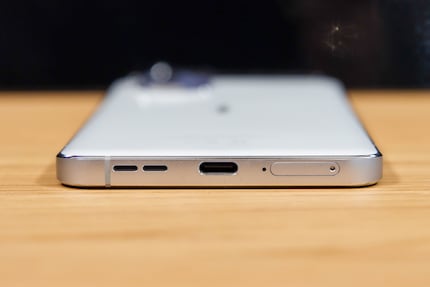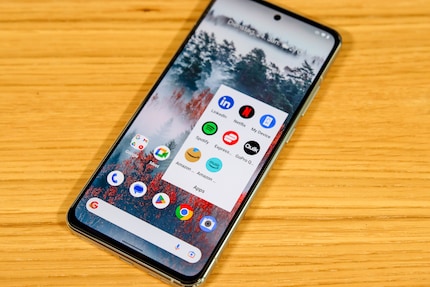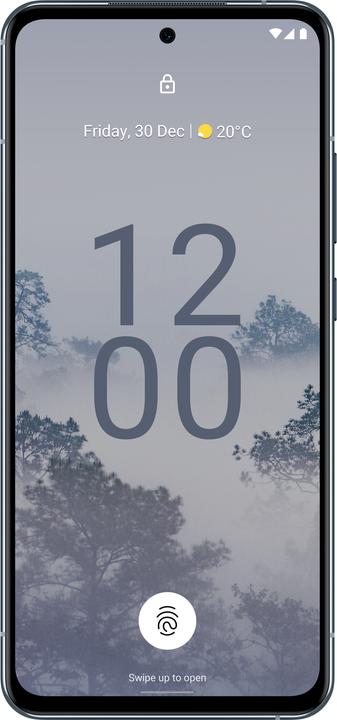

Nokia X30 review – when sustainability is the selling point
Nokia is trying to make the X30, its mid-range smartphone, palatable with sustainability. That’s commendable. But it’s also shady.
The X30 is Nokia’s current top-of-the-line smartphone. In the grand scheme of things, though, its specs make it a mid-range model – most notably its processor and number of cameras. The casing is made of recycled materials and the battery is supposed to be longer-lasting than is standard.
Recycled material doesn’t mean bad design
In an effort to further sustainability, HMD Global, the company behind Nokia smartphones, relies on recycled materials. The aluminium frame of the X30, for example, is made of 100 per cent recycled metal and the back is made of 65 per cent recycled plastic. That sounds nice and all, but it’s really nothing new. Other manufacturers are also increasingly turning to recycled materials. In any case, I haven’t noticed any negative effects on build quality in terms of feel or looks. The entire case is even IP67 waterproof, meaning it survived 30 minutes submerged in 1.5 metres of water in testing without being damaged.

Source: Jan Johannsen
The 6.43-inch AMOLED display is protected with the robust Gorilla Glass Victus. It’s got a 2400 × 1080 resolution paired with a 90 hertz refresh rate and 450 nits of brightness. These aren’t top-notch specs, but the screen looks good and remains perfectly usable in sunlight. Compared to other smartphones, the display is very white and cool. However, you can tweak the settings and add either some yellow for more warmth or blue for an even cooler image.

Source: Jan Johannsen
The in-display fingerprint sensor is reliable and quick, but not the speediest of its kind. The Nokia X30 doesn’t offer face recognition, meaning your other options for unlocking the phone are a password, PIN or pattern.
Two cameras with low contrast and low zoom
On the back of the Nokia X30 are two cameras. That’s not many for a current smartphone but isn’t necessarily a disadvantage. Cheaper models in particular may include a third camera that’s often so bad as to be unusable. HMD Global opted for a 50-megapixel main camera and a 13-megapixel ultra-wide-angle camera. With that, the maximum zoom – 8x – is purely digital.

Source: Jan Johannsen
The Nokia X30’s limits become apparent in the case of very colourful shots. Compared to other phones, the colours look washed out. The result isn’t true to colour. I’m missing intensity. On the other hand, the level of detail is at least decent – sufficient that the writing on the stickers below is easily legible.

Source: Jan Johannsen
For comparison, here’s the same scene shot on the Pixel 7 Pro.

Source: Jan Johannsen
If the subject of the photo isn’t so vibrant, the X30’s colour reproduction is less of an issue. This becomes clear when looking at the Elbphilharmonie in Hamburg. I went ahead and also photographed it with the wide-angle camera as well as with zoom.

Source: Jan Johannsen

Source: Jan Johannsen

Source: Jan Johannsen

Source: Jan Johannsen
The wide-angle camera performs well and, most notably, is no worse than the main camera. Of course, it has room for improvement in terms of colour reproduction, but that’s another matter. The digital zoom still delivers usable images at 2x magnification. At max zoom, i.e. 8x magnification, the level of detail decreases significantly.
If you’re shooting at night, it’s worth using night mode. It brightens the image just a bit, mainly providing higher detail and therefore a clearer picture.

Source: Jan Johannsen

Source: Jan Johannsen
The front-facing camera gives you 16 megapixels and works very well even against the light. It could deliver a bit more vibrant colours, too, but the level of detail is high. Portrait mode, on the other hand, isn’t worth using; while the software does a neat job emphasising me against the blurred background, the border itself is a blurry line. It makes it look like there’s an aura emanating from my body.

Source: Jan Johannsen

Source: Jan Johannsen
Night mode is worth activating in the dark for the front-facing camera, too. It delivers much better quality, though it’s still far from outstanding. To be fair, even top-of-the-line smartphones struggle with nighttime selfies – something I most recently noticed on the Huawei Mate 50.

Source: Jan Johannsen
Usable power and a battery with a – presumably – long lifespan
The Nokia X30 is equipped with the Snapdragon 695, which has six gigabytes of working memory. This is perfectly sufficient for everyday use. Apps launch quickly enough, image data is processed with no problems and using the phone doesn’t feel jerky. High-end smartphones are a bit faster, though –
something that becomes apparent when looking at the Geekbench 5 results. The benchmark test simulates various activities and subsequently assigns scores. Here, the Nokia X30 falls behind other mid-range smartphones like the Nothing Phone (1), Samsung Galaxy A53 and OnePlus Nord 2T. The only exception is the X30’s single-core score compared to two of the phones.
| Geekbench 5 | Single- / multi-core | Vulkan | SoC |
|---|---|---|---|
| Nokia X30 | 657 points / 1,926 points | 1,188 points | Snapdragon 695 |
| Nothing Phone (1) | 816 points / 2,970 points | 2,476 points | Snadragon 778G+ |
| OnePlus Nord 2T | 500 points / 2,868 points | 4,687 points | Dimensity 1300 |
| Samsung Galaxy A53 | 450 points / 1,806 points | 2,571 points | Exynos 1280 |
| OnePlus 8T | 869 points / 3,080 points | 3,415 points | Snapdragon 865 |
In the benchmark, even an over-two-year-old high-end model like the OnePlus 8T with Snapdragon 865 easily pulls ahead of the current-generation mid-range Nokia X30.
Another feature HMD Global uses to tout the sustainability of the Nokia X30 is its battery: it’s supposed to last 800 charging cycles instead of the typical 400 to 500. That sounds great, but I can’t test this over this short a time period.

Source: Jan Johannsen
At 4,200 mAh, the battery’s capacity is rather low. Then again, the phone doesn’t consume all that much power; with everyday use, it easily lasts me through the day on a single charge. HMD Global goes so far as to advertise two days – but I’d have to hold back on my usage to achieve that. There’s no power adapter included with the Nokia X30. The phone supports QuickCharge (QC3.0), PowerDelivery (PD3.0) and Programmable Power Supply (PPS) fast charging at up to 33 watts – not out-of-this-world speed, but perfectly serviceable. I won’t go into more detail, as a lot depends on the specific power adapter you use.
Android One – ft. preinstalled apps for the first time
Android 12 comes installed by default on the X30 Pro. But when you start up the smartphone, it doesn’t say «Android» – it says «Android One». By participating in this programme, manufacturers get access to an almost unchanged Android version that Google supplies with updates. That’s the theory. In practice, this doesn’t give Nokia a leg up on other manufacturers who have to adapt their user interfaces.
What this means for the X30 is that there’s still no information on when the update to Android 13 will be released. But come it should; HMD Global has promised updates up to Android 15, as well as security updates for three years.

Source: Jan Johannsen
I like the clean UI on Nokia phones. However, the X30 is the first time I’ve seen third-party apps preinstalled on a Nokia. Seven is still a manageable number compared to Huawei, but it’s a slippery slope for HMD Global. To make matters worse, you can’t uninstall the apps in the pop-up menu; you have to go into the app info to do that.
Verdict: sustainability alone isn’t enough
Here’s how I’d summarise the Nokia X30: exemplary chassis materials, decent display, good battery life, below-average camera, mediocre performance and initial software weaknesses. After weighing all the pros and cons, I say the Nokia X30 offers too little even for a mid-range smartphone.
I find it rather suspicious when the manufacturer starts touting sustainability as the selling point for its device. It’d seem better if there were other aspects to stress. Sustainability – here the use of recycled materials in the phone casing – should be a secondary point.
If you’re on the hunt for a smartphone in the Nokia X30’s price range, I recommend the Nothing Phone (1), the Samsung Galaxy A53 or the OnePlus Nord 2T. Each of these phones impressed me more than the X30 – and some of them are cheaper.
Header image: Jan Johannsen
When I was but a young student, I'd sit in my friend's living room with all my classmates and play on his SuperNES. Since then I've had the opportunity to test out all the newest technology for you. I've done reviews at Curved, Computer Bild and Netzwelt, and have now arrived at Galaxus.de.




